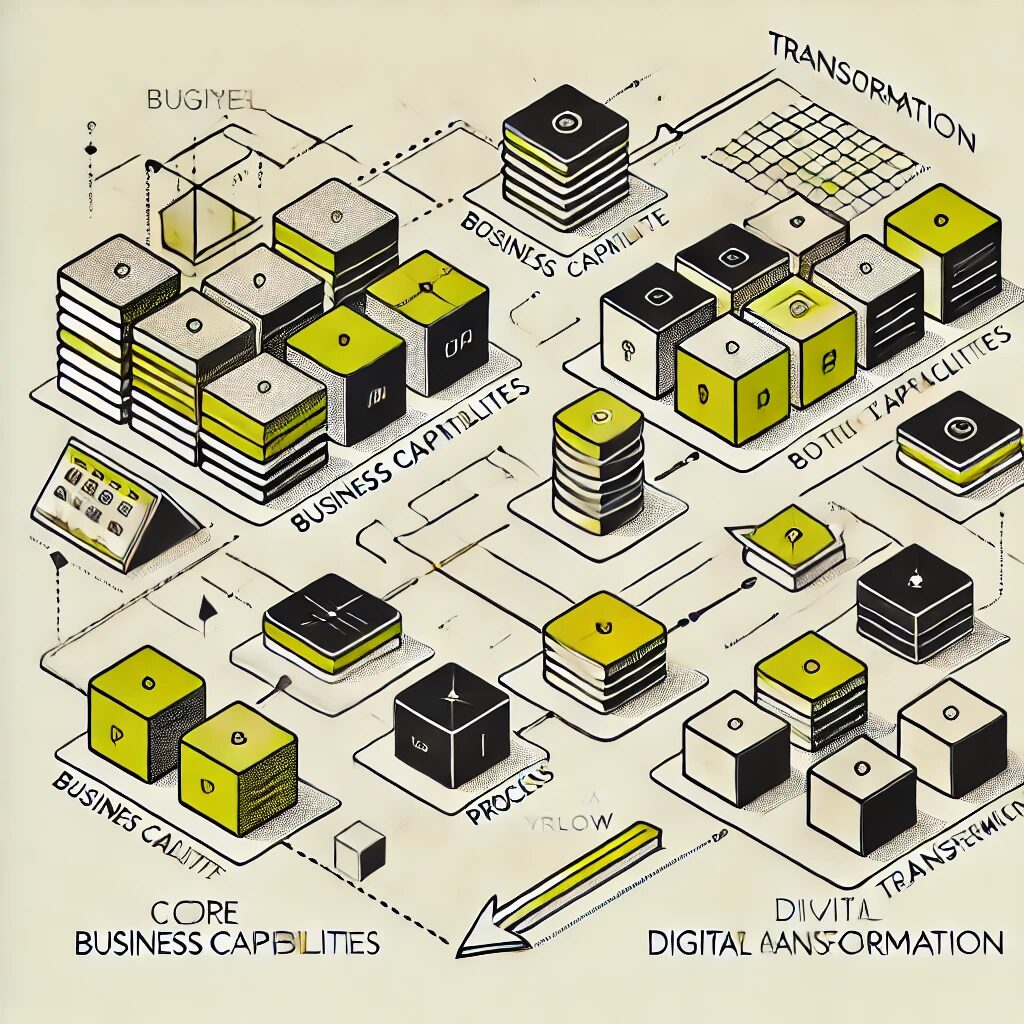
Streamlining Payment Excellence with Value Streams. Transform Payments from Transactions to Value Drivers.
In today’s hyper-competitive payments landscape, operational efficiency has evolved from a cost-saving initiative to a strategic imperative. Traditional organizational silos, fragmented customer journeys, and complex technology ecosystems create friction that hampers growth, increases costs, and degrades customer experience. The most successful payment organizations have discovered that business architecture value streams provide the critical framework for identifying and eliminating these operational barriers.
Unlike traditional process maps or LEAN methodologies that focus on how work is performed, business architecture value streams capture end-to-end value delivery from the customer perspective. By creating this comprehensive view of value creation, payment organizations gain unprecedented clarity into operational bottlenecks, cross-functional dependencies, and optimization opportunities that directly impact strategic outcomes and customer satisfaction.
1: Understanding Business Architecture Value Streams
Business architecture value streams provide a customer-centric view of how organizations deliver value, independent of internal structures and processes. For payment companies, value streams create the foundation for operational optimization by revealing the end-to-end flow of value from initial customer need to final fulfillment.
- Value Focus: Value streams map the stages of value delivery from trigger to outcome, prioritizing customer-perceived value over internal activities or departmental boundaries.
- Operational Lens: Unlike capability maps that show what an organization does, value streams illustrate how value flows through capabilities to deliver outcomes that matter to customers.
- Cross-Functional Visibility: Value streams reveal the organizational handoffs and dependencies that cause 70% of operational delays and customer experience breakdowns in payment organizations.
- Strategic Alignment: Well-designed value streams connect operational activities directly to strategic objectives, ensuring improvement initiatives deliver meaningful business impact.
- Transformation Foundation: Value stream analysis provides the essential context for technology investments, process improvements, and organizational changes that drive operational excellence.
2: The Value Stream Advantage for Payments
Payment organizations face unique operational challenges that value stream mapping directly addresses. From customer onboarding to dispute resolution, value streams reveal the critical inefficiencies that impact both customer experience and business performance.
- End-to-End Perspective: Value streams capture the complete customer journey across organizational boundaries, revealing the fragmentation that causes most payment experience problems.
- Waste Identification: Value stream analysis typically identifies that 30-50% of payment processing activities add no customer value and can be eliminated or automated.
- Performance Insight: Mapping value streams to KPIs reveals precisely how operational inefficiencies impact critical metrics like authorization rates, settlement times, and customer satisfaction.
- Resource Optimization: Value stream analysis shows where skilled resources are consumed by low-value activities, enabling reallocation to strategic priorities.
- Technology Context: Value streams provide the business context for technology decisions, ensuring investments target the systems that directly impact value delivery.
Did You Know
- According to McKinsey, payment organizations that use business architecture value streams to guide operational optimization achieve 25-40% higher returns on their transformation investments compared to those using traditional process improvement methods.
3: Essential Payment Value Streams
Payment organizations typically operate 15-20 distinct value streams that deliver specific customer outcomes. Understanding these core value streams creates the foundation for comprehensive operational optimization.
- Customer Acquisition: This value stream encompasses the stages from initial prospect targeting through successful onboarding, where payment firms typically lose 30-40% of potential customers due to process friction.
- Payment Acceptance: This core value stream includes authorization, clearing, and settlement stages that form the heart of payment operations and directly impact both revenue and customer experience.
- Account Management: This value stream manages the ongoing customer relationship, including configuration changes, limit adjustments, and feature enablement that drive retention and wallet share.
- Dispute Resolution: This high-impact value stream handles exceptions including chargebacks, fraud claims, and transaction errors that disproportionately influence customer satisfaction.
- Merchant Settlement: This critical value stream manages the complex processes ensuring merchants receive funds accurately and timely, directly impacting partner satisfaction and retention.
4: Anatomy of Payment Value Streams
Effective value stream mapping requires a structured approach that balances strategic insight with operational detail. Understanding the components of well-designed payment value streams ensures they drive meaningful business results.
- Value Stream Definition: Each value stream represents a distinct flow of value with clear triggering events, participating stakeholders, and measurable outcomes that matter to customers.
- Stage Decomposition: Value streams typically break down into 5-9 stages that represent significant value delivery milestones within the end-to-end flow.
- Capability Alignment: Each value stream stage utilizes specific business capabilities, creating the critical connection between what the organization does and how value flows to customers.
- Performance Metrics: Well-designed value streams include KPIs that measure both efficiency (time, cost, quality) and effectiveness (customer satisfaction, business outcomes) at each stage.
- Stakeholder Mapping: Value streams identify all participating stakeholders and their specific roles, revealing coordination requirements and accountability gaps.
5: Value Stream Mapping Methodology
Creating effective payment value streams requires a structured methodology that delivers actionable insights rather than academic diagrams. This systematic approach ensures value streams drive operational optimization rather than becoming shelf-ware.
- Discovery Workshops: Successful value stream mapping begins with cross-functional workshops that capture diverse perspectives on how value flows to customers.
- Customer Journey Alignment: Value streams should directly align with customer journeys, ensuring they capture experience from the customer perspective rather than internal viewpoints.
- Capability Overlay: Mapping capabilities to value stream stages reveals exactly which business functions contribute to each step in value delivery.
- Pain Point Identification: Systematic analysis identifies friction points, bottlenecks, and breakdowns within value streams that constrain operational performance.
- Prioritization Framework: Value impact scoring ensures optimization efforts focus on the highest-impact opportunities rather than easy fixes.
6: Value Stream-Based Pain Point Resolution
Payment operations typically suffer from specific friction points that value stream analysis reveals. Identifying these pain points within their value stream context enables targeted resolution that delivers maximum business impact.
- Handoff Inefficiencies: Value stream mapping reveals that payment operations typically include 7-9 organizational handoffs per value stream, each creating 20-30% process delays.
- Approval Bottlenecks: Value stream analysis identifies approval steps that add minimal risk management value while significantly delaying customer outcomes.
- Data Rekeying: Value streams highlight where critical customer and transaction data is manually re-entered between systems, creating both delays and error risks.
- Exception Proliferation: Value stream mapping shows how exception handling routinely consumes 40-60% of operational resources despite representing only 10-15% of transaction volume.
- Redundant Controls: Value stream analysis identifies overlapping control points that add complexity and cost without proportional risk reduction benefits.
7: Value Stream-Driven Process Optimization
Value streams provide the strategic context for tactical process improvements. This alignment ensures process optimization delivers meaningful business outcomes rather than localized efficiency gains.
- End-to-End Redesign: Value stream context enables process redesign focused on overall customer outcomes rather than departmental efficiency, typically reducing process steps by 30-50%.
- Cross-Functional Integration: Value stream analysis drives process integration across organizational boundaries, eliminating the handoffs that cause most operational delays.
- Exception Handling: Value stream-based process design creates streamlined exception paths that reduce resolution times by 40-60% while improving customer satisfaction.
- Control Rationalization: Value stream context enables intelligent control design that maintains risk management effectiveness while reducing process complexity.
- Automation Targeting: Value stream analysis identifies high-volume, low-complexity process segments that deliver maximum return on automation investments.
8: Value Stream-Aligned Technology Optimization
Technology complexity significantly constrains payment operations. Value streams provide the business context essential for technology rationalization that enhances rather than impedes value delivery.
- System Mapping: Value stream analysis reveals exactly which systems support each stage of value delivery, identifying both redundancy and integration requirements.
- Technical Debt Impact: Value stream context shows precisely where technical debt creates operational constraints and customer experience breakdowns requiring priority remediation.
- Integration Requirements: Value stream mapping identifies the critical integration points where system disconnects create manual workarounds and process inefficiencies.
- Automation Opportunities: Value stream analysis reveals high-volume, rule-based activities within value streams that deliver maximum return on automation investments.
- Technology Roadmap: Value stream context enables technology planning that prioritizes investments based on business impact rather than technical elegance.
9: Value Stream-Driven Organizational Alignment
Organizational silos represent a significant barrier to operational excellence in payment companies. Value streams provide the foundation for organizational models that optimize end-to-end value delivery rather than functional efficiency.
- Role Clarification: Value stream mapping clearly defines which functions contribute to each value delivery stage, eliminating confusion and accountability gaps.
- Governance Redesign: Value stream-based governance establishes clear decision rights across organizational boundaries, accelerating operational decisions by 30-50%.
- Performance Metrics: Value stream context enables performance measures that reflect contribution to customer outcomes rather than departmental targets.
- Team Alignment: Progressive organizations evolve toward value stream-aligned teams that eliminate the handoffs causing most operational inefficiencies.
- Skill Assessment: Value stream analysis identifies precisely which capabilities require enhanced skills to improve overall value delivery performance.
10: Value Stream-Based Customer Experience Enhancement
Customer experience has become the primary battleground for payment organizations. Value streams provide the framework for experience enhancement initiatives that deliver maximum impact.
- Experience Mapping: Value stream overlay on customer journeys reveals exactly where internal constraints create experience friction requiring remediation.
- Moment Analysis: Value stream context identifies the critical “moments of truth” within customer journeys that disproportionately influence satisfaction and loyalty.
- Channel Optimization: Value stream mapping across channels highlights inconsistencies and friction points that confuse customers and increase support costs.
- Personalization Opportunities: Value stream analysis reveals where contextual information can enhance customer interactions to improve relevance and satisfaction.
- Feedback Integration: Value stream-aligned voice-of-customer programs ensure improvement initiatives directly address customer-identified pain points.
11: Value Stream-Based Analytics and Measurement
Measurement drives improvement in payment operations. Value streams provide the framework for analytics that deliver actionable insights rather than data overload.
- KPI Alignment: Value stream context enables performance metrics that measure contribution to customer outcomes rather than departmental efficiency.
- Predictive Analytics: Value stream data enables predictive models that identify emerging operational issues before they impact customer experience.
- Root Cause Analysis: Value stream context facilitates systematic diagnosis of performance issues across organizational boundaries.
- Benchmarking Framework: Value stream metrics enable meaningful performance comparison against industry peers and best practices.
- Continuous Improvement: Value stream measurement creates the feedback loop essential for sustained operational enhancement rather than one-time fixes.
12: Implementing Value Stream-Based Transformation
Developing value stream maps creates potential value, but implementation delivers actual business results. A structured approach to value stream-based transformation ensures meaningful operational improvement.
- Executive Sponsorship: Successful transformation requires C-suite champions who understand how value stream optimization directly impacts strategic objectives.
- Cross-Functional Governance: Value stream transformation demands governance mechanisms that transcend organizational silos and enable end-to-end optimization.
- Prioritization Framework: Implementation should focus on value streams with highest business impact and organizational readiness rather than attempting comprehensive transformation.
- Quick Win Identification: Early transformation phases should target high-visibility pain points that demonstrate value and build momentum for broader initiatives.
- Change Management: Effective implementation requires systematic attention to the cultural and behavioral changes necessary for sustained operational excellence.
13: Value Stream Integration with Business Architecture
Value streams deliver maximum impact when integrated with other business architecture domains. This holistic approach ensures operational optimization aligns with strategic priorities and architectural governance.
- Capability Alignment: Mapping capabilities to value streams reveals exactly which business functions require enhancement to improve overall value delivery.
- Information Flow Analysis: Value stream context identifies the critical information requirements that enable seamless value delivery across organizational boundaries.
- Technology Architecture: Value stream integration with technology architecture ensures system investments directly enhance value delivery rather than creating additional complexity.
- Process Architecture: Value streams provide the strategic context for process design that optimizes end-to-end outcomes rather than departmental efficiency.
- Performance Framework: Integrated architecture enables performance measurement that connects operational metrics directly to strategic objectives.
14: Measuring Value Stream Transformation Success
Value stream-based transformation must demonstrate measurable business impact to maintain executive support and funding. A balanced scorecard approach helps quantify both immediate results and long-term value.
- Operational Metrics: Value stream enhancement typically improves key operational indicators including processing times (30-50% reduction), error rates (40-60% reduction), and straight-through processing (20-40% improvement).
- Financial Outcomes: Mature value stream optimization delivers measurable financial results including operational cost reduction (15-25%), revenue growth (10-15%), and improved capital efficiency (20-30%).
- Customer Impacts: Value stream transformation directly enhances customer experience with typical improvements in satisfaction scores (15-25%), retention rates (10-20%), and Net Promoter Scores (20-30 points).
- Employee Benefits: Value stream clarity improves employee experience with measurable gains in engagement scores (15-20%), reduced turnover (20-30%), and increased innovation contributions (40-60%).
- Strategic Alignment: Value stream optimization strengthens strategic execution with improvements in time-to-market (30-50%), change adoption (40-60%), and strategic initiative success rates (30-50%).
Did You Know
- Forrester research indicates that payment organizations using value stream-driven process optimization achieve 30-40% higher straight-through processing rates and 20-30% lower operational costs compared to those using traditional process improvement approaches.
15: Future-Proofing Payment Value Streams
The payments landscape continues to evolve rapidly. Maintaining the strategic relevance of your value streams requires systematic monitoring of industry trends and potential disruptions.
- Emerging Value Creation: Regular horizon scanning identifies new customer expectations and value propositions that require enhanced or entirely new value streams.
- Ecosystem Evolution: Value streams must increasingly extend beyond organizational boundaries to include partners, regulators, and platforms that influence value delivery.
- Technology Impact: Forward-looking value stream planning assesses how emerging technologies like AI, blockchain, and embedded finance will transform payment value delivery.
- Regulatory Anticipation: Value stream governance must proactively address emerging regulatory requirements to maintain compliance without compromising efficiency.
- Competitive Monitoring: Regular assessment of competitor value streams helps identify strategic gaps and innovation opportunities requiring accelerated transformation.
Takeaway
Business architecture value streams provide payment organizations with an essential framework for operational optimization that directly impacts strategic outcomes. By creating a comprehensive view of how value flows to customers, value streams reveal the cross-functional dependencies, bottlenecks, and inefficiencies that constrain performance but remain hidden in traditional organizational structures. Payment organizations that master value stream-based transformation consistently outperform competitors in operational efficiency, customer experience, employee engagement, and strategic agility. In an industry where invisible payments have become the goal, value streams make the path to operational excellence visible and actionable.
Next Steps
- Identify 2-3 high-priority value streams based on strategic importance, customer impact, and operational pain points.
- Conduct cross-functional value stream mapping workshops that bring together stakeholders from all participating departments.
- Overlay current capabilities, systems, and performance metrics on priority value streams to identify critical constraints and improvement opportunities.
- Develop a prioritized transformation roadmap that sequences initiatives based on business impact, implementation complexity, and dependency management.
- Establish value stream governance mechanisms that enable sustained cross-functional optimization rather than one-time improvement projects.



